High-Speed Dicing of SiC Wafers with 0.048 mm Diamond Blades via Rolling-Slitting
Abstract
1. Introduction
2. Materials and Methods
2.1. Materials
2.2. Fabrication Procedure
2.2.1. Mixing Process
2.2.2. Forming and Slitting
2.2.3. Debinding and Sintering
2.2.4. Surface Polishing
2.3. Analytical Method
3. Result and Discussions
3.1. Density and Phase Composition of Green and Sintered Samples
3.2. Microstructure of the Dicing Blade with Different Forming Methods
3.3. Influence of Dicing Parameters on SiC Surface Quality
3.3.1. The Effects of the Spindle Speed
3.3.2. The Effects of the Dicing Depth
3.3.3. The Effects of the Feed Rate
4. Conclusions
- (1)
- An innovative fabrication method named rolling-slitting for ultra-thin diamond dicing blades was proposed for the first time. The new fabrication method can achieve high precision and thin thickness, reaching up to 0.048 mm without grinding-thinning. This method facilitates cost-effective and continuous production without dies.
- (2)
- The porous structures formed in situ of rolling-slitting diamond blades are realized, and residual pyrolysis carbon forms a lubrication film that can reduce dicing resistance and achieve ultra-narrow and self-sharpening during the dicing of silicon carbide chips.
- (3)
- The dicing performance of rolling-slitting blades and cold-pressed blades was comparatively studied and the influence of the dicing parameters on the quality of silicon carbide cutting was investigated as well. For a dicing depth of 0.2 mm, the ideal SiC dicing with an ultra-thin blade was achieved at a spindle speed of 22,000 rpm and a feed rate of 5 mm/s.
5. Patents
Author Contributions
Funding
Institutional Review Board Statement
Informed Consent Statement
Data Availability Statement
Conflicts of Interest
References
- Lee, H.; Smet, V.; Tummala, R. A review of SiC power module packaging technologies: Challenges, advances, and emerging issues. IEEE J. Emerg. Sel. Top. Power Electron. 2019, 8, 239–255. [Google Scholar] [CrossRef]
- Wu, J.; Ren, N.; Guo, Q.; Sheng, K. A comparative study of silicon carbide merged PiN schottky diodes with electrical-thermal coupled considerations. Materials 2020, 13, 2669. [Google Scholar] [CrossRef] [PubMed]
- Nakamura, D.; Gunjishima, I.; Yamaguchi, S.; Ito, T.; Okamoto, A.; Kondo, H.; Onda, S.; Takatori, K.J.N. Ultrahigh-quality silicon carbide single crystals. Nature 2004, 430, 1009–1012. [Google Scholar] [CrossRef] [PubMed]
- Rakshit, R.; Das, A.K. A review on cutting of industrial ceramic materials. Precis. Eng. 2019, 59, 90–109. [Google Scholar] [CrossRef]
- Goel, S. The current understanding on the diamond machining of silicon carbide. J. Phys. D Appl. Phys. 2014, 47, 243001. [Google Scholar] [CrossRef]
- Han, W.; Kunieda, M. Precision electrochemical machining of tungsten micro-rods using wire electrochemical turning method. Int. J. Adv. Manuf. Technol. 2020, 111, 295–307. [Google Scholar] [CrossRef]
- Nishikawa, H.; Okada, Y.; Yamamura, K.; Matsuyama, S.; Yamauchi, K. Dicing of SiC wafer by atmospheric-pressure plasma etching process with slit mask for plasma confinement. In Materials Science Forum; Trans Tech Publications Ltd.: Bäch, Switzerland, 2014; Volume 778, pp. 759–762. [Google Scholar]
- Zhang, Y.; Li, R.; Zhang, Y.; Liu, D.; Deng, H. Indiscriminate revelation of dislocations in single crystal SiC by inductively coupled plasma etching. J. Eur. Ceram. Soc. 2019, 39, 2831–2838. [Google Scholar] [CrossRef]
- Zhang, Z.; Wen, Z.; Shi, H.; Song, Q.; Xu, Z.; Li, M.; Hou, Y.; Zhang, Z. Dual Laser Beam Asynchronous Dicing of 4H-SiC Wafer. Micromachines 2021, 12, 1331. [Google Scholar] [CrossRef]
- Wang, L.; Zhang, C.; Liu, F.; Zheng, H.; Cheng, G. Ultrafast pulsed laser stealth dicing of 4H-SiC wafer: Structure evolution and defect generation. J. Manuf. Process. 2022, 81, 562–570. [Google Scholar] [CrossRef]
- Yang, B.; Wang, H.; Peng, S.; Cao, Q. Precision Layered Stealth Dicing of SiC Wafers by Ultrafast Lasers. Micromachines 2022, 13, 1011. [Google Scholar] [CrossRef]
- Feng, S.; Huang, C.; Wang, J.; Zhu, H. Material removal of single crystal 4H-SiC wafers in hybrid laser-waterjet micromachining process. Mater. Sci. Semicond. Process. 2018, 82, 112–125. [Google Scholar] [CrossRef]
- Miao, X.; Qiang, Z.; Wu, M.; Song, L.; Ye, F. The optimal cutting times of multipass abrasive water jet cutting. Int. J. Adv. Manuf. Technol. 2018, 97, 1779–1786. [Google Scholar] [CrossRef]
- Hardin, C.W.; Qu, J.; Shih, A. Fixed abrasive diamond wire saw slicing of single-crystal silicon carbide wafers. Mater. Manuf. Process. 2004, 19, 355–367. [Google Scholar] [CrossRef]
- Fujita, T.; Izumi, Y.; Watanabe, J. Ultrafine ductile-mode dicing technology for SiC substrate with metal film using PCD blade. J. Adv. Mech. Des. Syst. Manuf. 2019, 13, JAMDSM0073. [Google Scholar] [CrossRef]
- Gao, A.; Huang, W.; Han, R. Research on SiC wafer dicing technology. Equpiment Electron. Prod. Manuf. 2020, 49, 32–35. [Google Scholar]
- Ya, C.; Con, Z.; Mei, Z.; Guo, Y. Experimental study of surface quality of monocrystalline SiC cut by ultra-thin diamond saw blade. Superhard Mater. Eng. 2017, 29, 8–13. [Google Scholar]
- Cvetković, S.; Morsbach, C.; Rissing, L. Ultra-precision dicing and wire sawing of silicon carbide (SiC). Microelectron. Eng. 2011, 88, 2500–2504. [Google Scholar] [CrossRef]
- Chu, J.P.; Lai, B.Z.; Yiu, P.; Shen, Y.L.; Chang, C.W. Metallic glass coating for improving diamond dicing performance. Sci. Rep. 2020, 10, 12432. [Google Scholar] [CrossRef]
- Wang, X.; Yuan, Z.; Zhuang, P.; Wu, T.; Feng, S. Study on precision dicing process of SiC wafer with diamond dicing blades. Nanotechnol. Precis. Eng. 2021, 4, 033004. [Google Scholar] [CrossRef]
- Xie, Y.; Deng, D.; Pi, G.; Huang, X.; Zhao, C. Fabrication of silicon carbide microchannels by thin diamond wheel grinding. Int. J. Adv. Manuf. Technol. 2020, 111, 309–323. [Google Scholar] [CrossRef]
- Wang, P.; Li, M.; Gao, L.; Meng, H.; Mu, D. The evaluation of chipping on single-crystal silicon carbide (SiC) dicing machining using sintered diamond blades. In Proceedings of the 2nd International Conference on Mechanical, Electronics, and Electrical and Automation Control (METMS 2022), Guilin, China, 25 April 2022. [Google Scholar]
- Li, M.; Mu, D.; Huang, S.; Wu, Y.; Meng, H.; Xu, X.; Huang, H. Ultrathin diamond blades for dicing single crystal SiC developed using a novel bonding method. J. Manuf. Process. 2022, 84, 88–99. [Google Scholar] [CrossRef]
- Yuan, Z.; Feng, S.; Wu, T. Preparation and characterization of ultra-thin dicing blades with different bonding properties. Int. J. Adv. Manuf. Technol. 2022, 119, 6819–6834. [Google Scholar] [CrossRef]
- Yuan, Z.; Cheng, K.; Zhang, Y.; Hu, J.; Zheng, P. Investigation on the fabrication of dicing blades with different sintering methods for machining hard-brittle material wafers. Proc. Inst. Mech. Eng. Part B J. Eng. Manuf. 2019, 233, 1781–1793. [Google Scholar] [CrossRef]
- Jie, Y.; Shuyi, G. Design of ultrathin diamond tool powder feeding system. Diam. Abras. Eng. 2016, 36, 87–90. [Google Scholar]
- Zou, Q.; Zhang, C.; Li, Y.; Li, K. Research present situation of machining deformation of ultra-thin dicing blades. Diam. Abras. Eng. 2022, 42, 119–128. [Google Scholar]
- Denkena, B.; Krödel, A.; Harmes, J.; Kempf, F.; Griemsmann, T.; Hoff, C.; Hermsdorf, J.; Kaierle, S. Additive manufacturing of metal-bonded grinding tools. Int. J. Adv. Manuf. Technol. 2020, 107, 2387–2395. [Google Scholar] [CrossRef]
- Kasonde, M.; Kanyanta, V. Future of superhard material design, processing and manufacturing. In Microstructure-Property Correlations for Hard, Superhard, and Ultrahard Materials; Springer: Berlin/Heidelberg, Germany, 2016; pp. 211–239. [Google Scholar]
- Su, Z.; Zhang, S.; Liu, L.; Wu, J. Microstructure and performance characterization of Co-based diamond composites fabricated via fused deposition molding and sintering. J. Alloys Compd. 2021, 871, 159569. [Google Scholar] [CrossRef]
- Lin, T.; Liu, S.; Ji, Z.; Shao, H.; Hao, J. Vitrified bond diamond grinding wheel prepared by gel-casting with 3D printing molds. Diam. Relat. Mater. 2020, 108, 107917. [Google Scholar] [CrossRef]
- Huang, J.; Lu, J.; Wang, Y.; Ma, Z. Fabrication of porous structure vitrified bond diamond grinding wheel via direct ink writing. Ceram. Int. 2021, 47, 34050–34058. [Google Scholar] [CrossRef]
- Tian, C.; Li, X.; Li, H.; Guo, G.; Wang, L.; Rong, Y. The effect of porosity on the mechanical property of metal-bonded diamond grinding wheel fabricated by selective laser melting (SLM). Mater. Sci. Eng. A 2019, 743, 697–706. [Google Scholar] [CrossRef]
- Wang, C.; Wang, D.; Tian, C.; Wang, L.; Rong, Y.; Li, X. Grinding performance evaluation of 3D-printed porous metal-bonded grinding wheel in BK7 glass grinding. Int. J. Adv. Manuf. Technol. 2021, 117, 1445–1457. [Google Scholar] [CrossRef]
- Tian, C.; Li, X.; Chen, Z.; Guo, G.; Wang, L.; Rong, Y. Study on formability, mechanical property and finite element modeling of 3D-printed composite for metal-bonded diamond grinding wheel application. J. Manuf. Process. 2020, 54, 38–47. [Google Scholar] [CrossRef]
- Li, M.; Huang, J.; Fang, A.; Mansoor, B.; Pei, Z.; Ma, C. Binder jetting additive manufacturing of copper/diamond composites: An experimental study. J. Manuf. Process. 2021, 70, 205–213. [Google Scholar] [CrossRef]
- Gan, J.; Gao, H.; Wen, S.; Zhou, Y.; Tan, S.; Duan, L. Simulation, forming process and mechanical property of Cu-Sn-Ti/diamond composites fabricated by selective laser melting. Int. J. Refract. Met. Hard Mater. 2020, 87, 105144. [Google Scholar] [CrossRef]
- Li, M.; Du, W.; Elwany, A.; Pei, Z.; Ma, C. Metal binder jetting additive manufacturing: A literature review. J. Manuf. Sci. Eng. 2020, 142, 090801. [Google Scholar] [CrossRef]
- Lin, J.; Cheng, M. Investigation of chipping and wear of silicon wafer dicing. J. Manuf. Process. 2014, 16, 373–378. [Google Scholar] [CrossRef]
- Xue, M.; Chen, T.; Zhang, X.; Gao, L.; Li, M. Effect of blade dicing parameters on Die strength. In Proceedings of the 2018 19th International Conference on Electronic Packaging Technology (ICEPT), Shanghai, China, 8–14 August 2018; pp. 180–183. [Google Scholar]
- Gamkrelidze, S.; Trofimov, A.; Shchavruk, N.J.R.M. Effect of diamond dicing of SiC device wafers on the technical and operational parameters of monolithic integrated circuits. J. Russ. Microelectron. 2017, 46, 323–328. [Google Scholar] [CrossRef]
- Yuan, Z.; Hu, J.; Wen, Q.; Cheng, K.; Zheng, P. Investigation on an innovative method for high-speed low-damage micro-cutting of CFRP composites with diamond dicing blades. Materials 2018, 11, 1974. [Google Scholar] [CrossRef]
- Adachi, T.; Matsumaru, K.; Ishizaki, K. Fabrication of highly efficient dicing blade for cutting Al2O3-TiC composite. J. Ceram. Soc. Jpn. 2006, 114, 336–340. [Google Scholar] [CrossRef][Green Version]
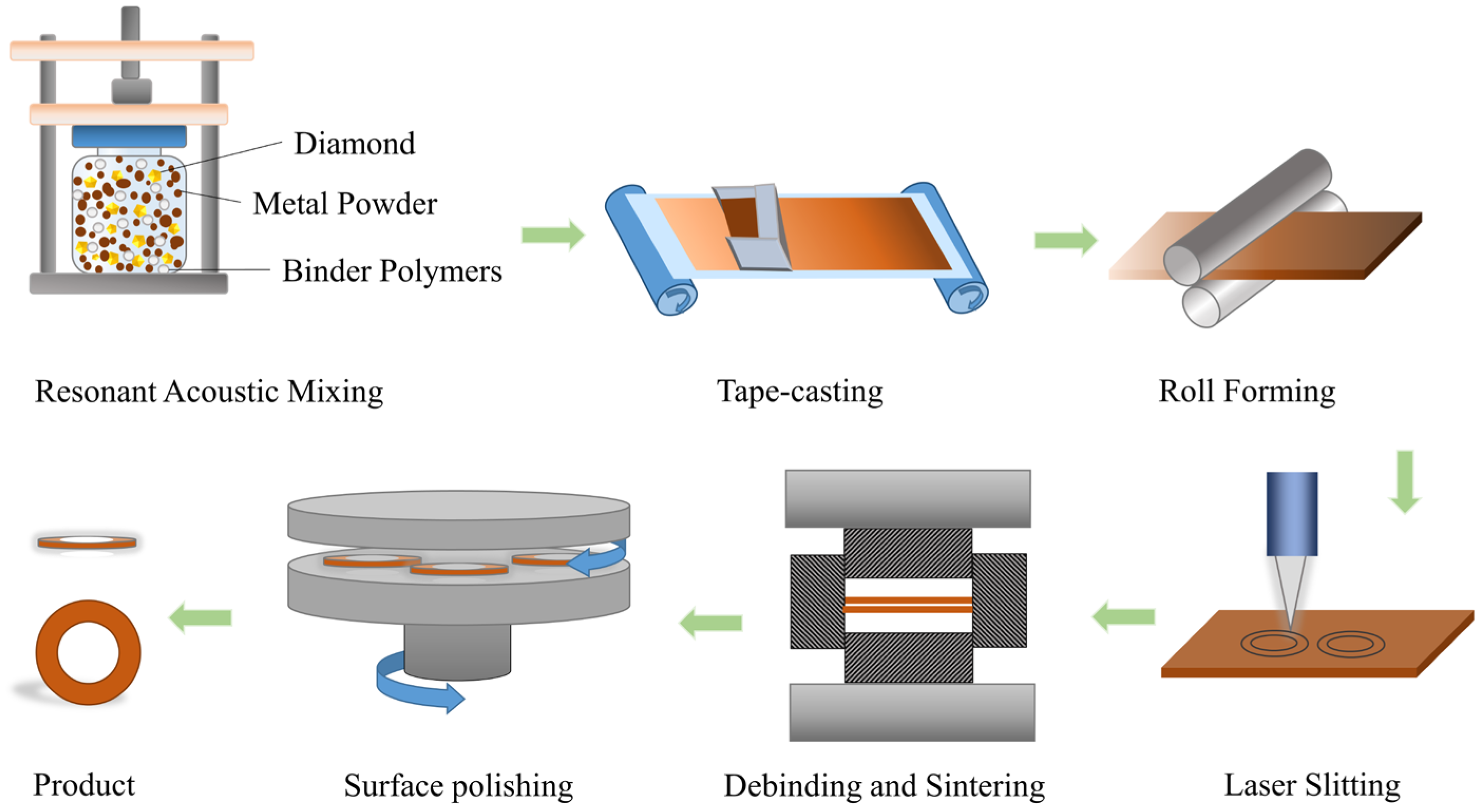
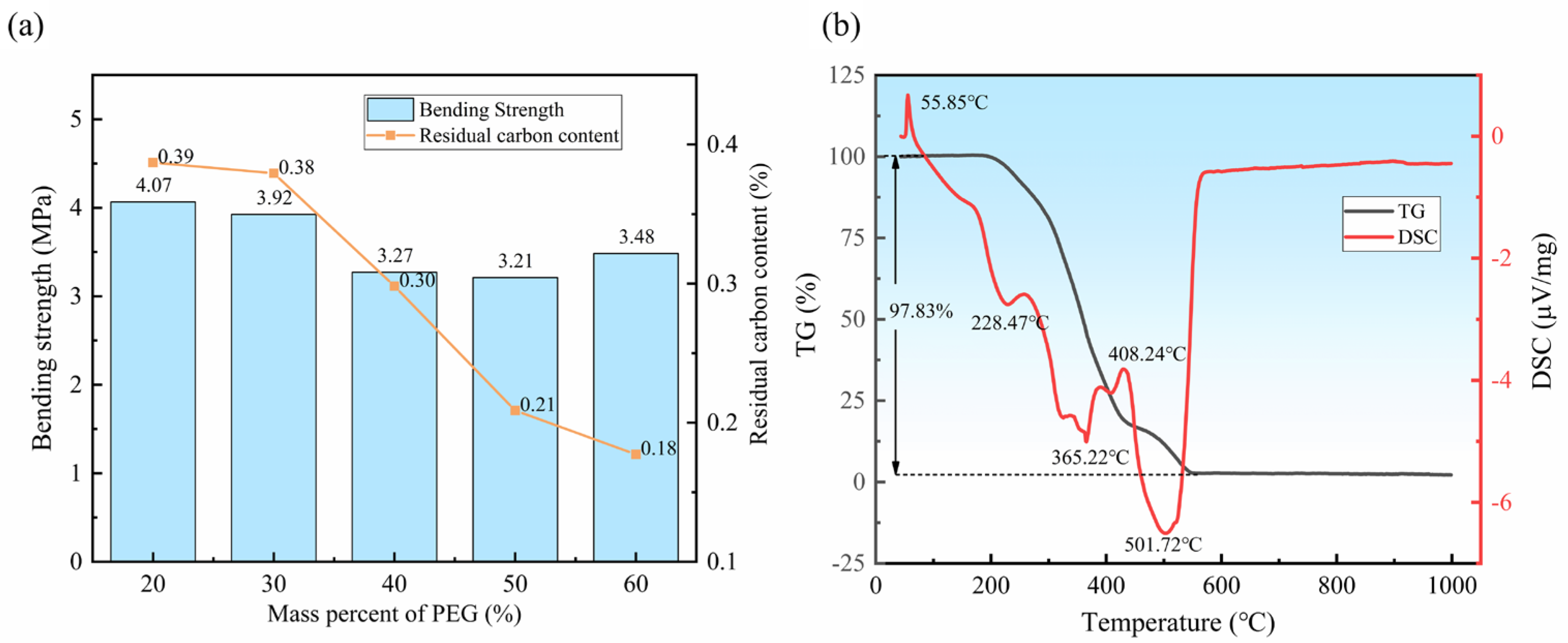
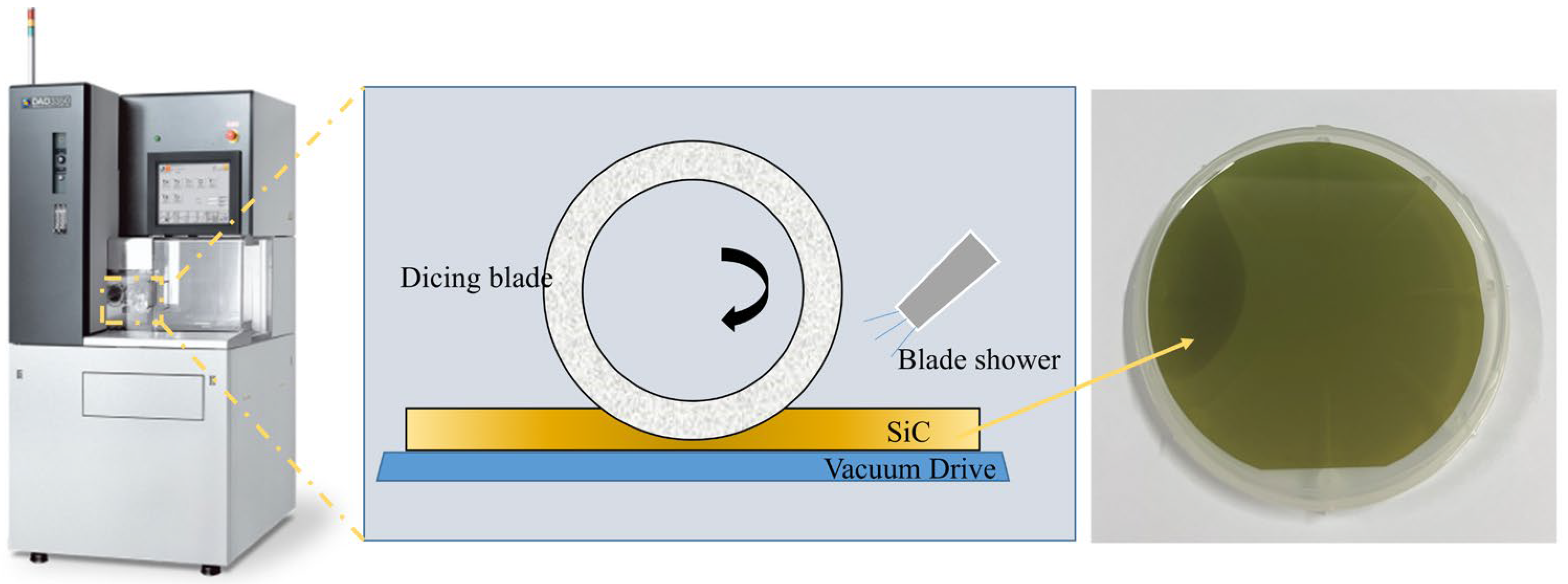
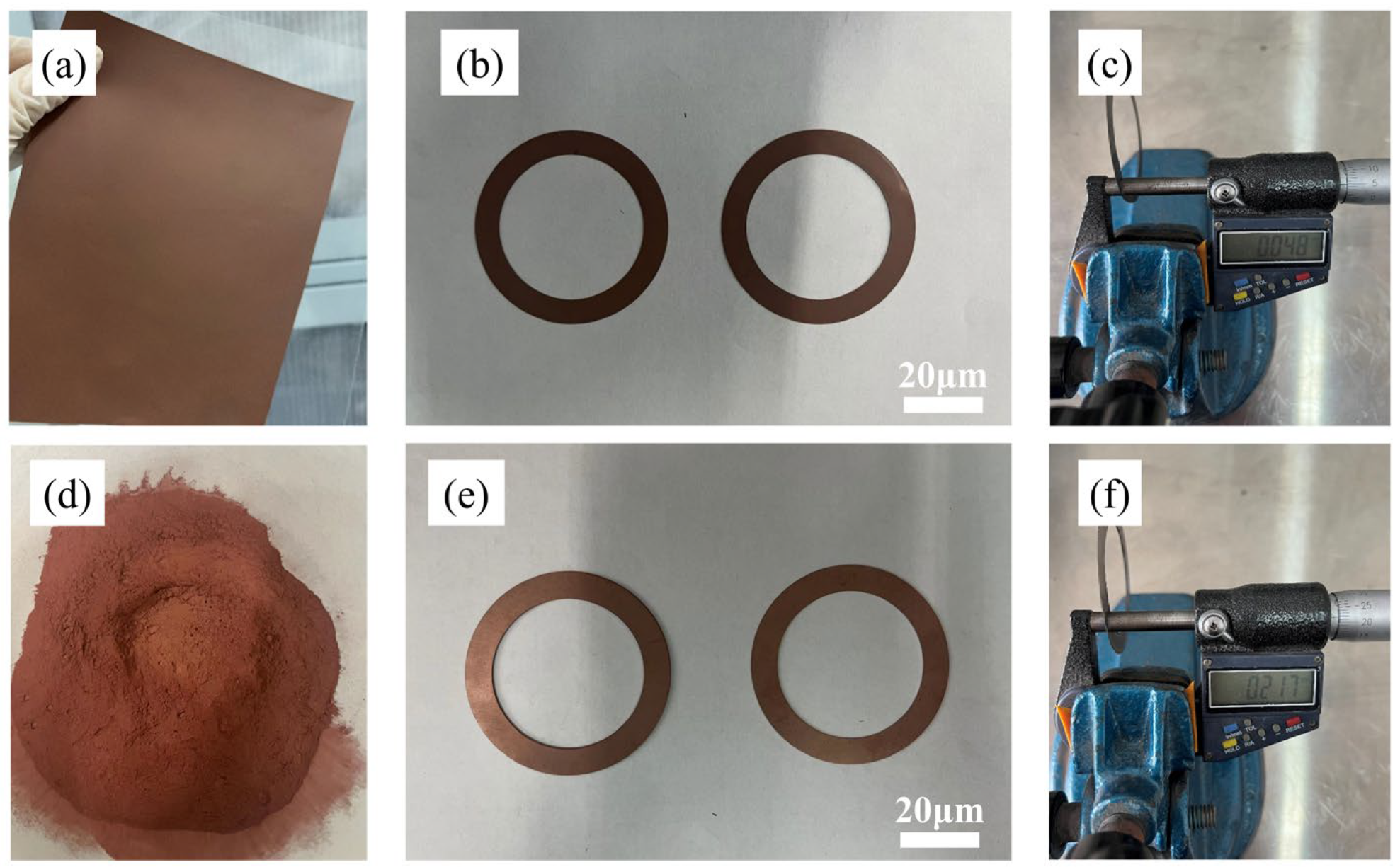
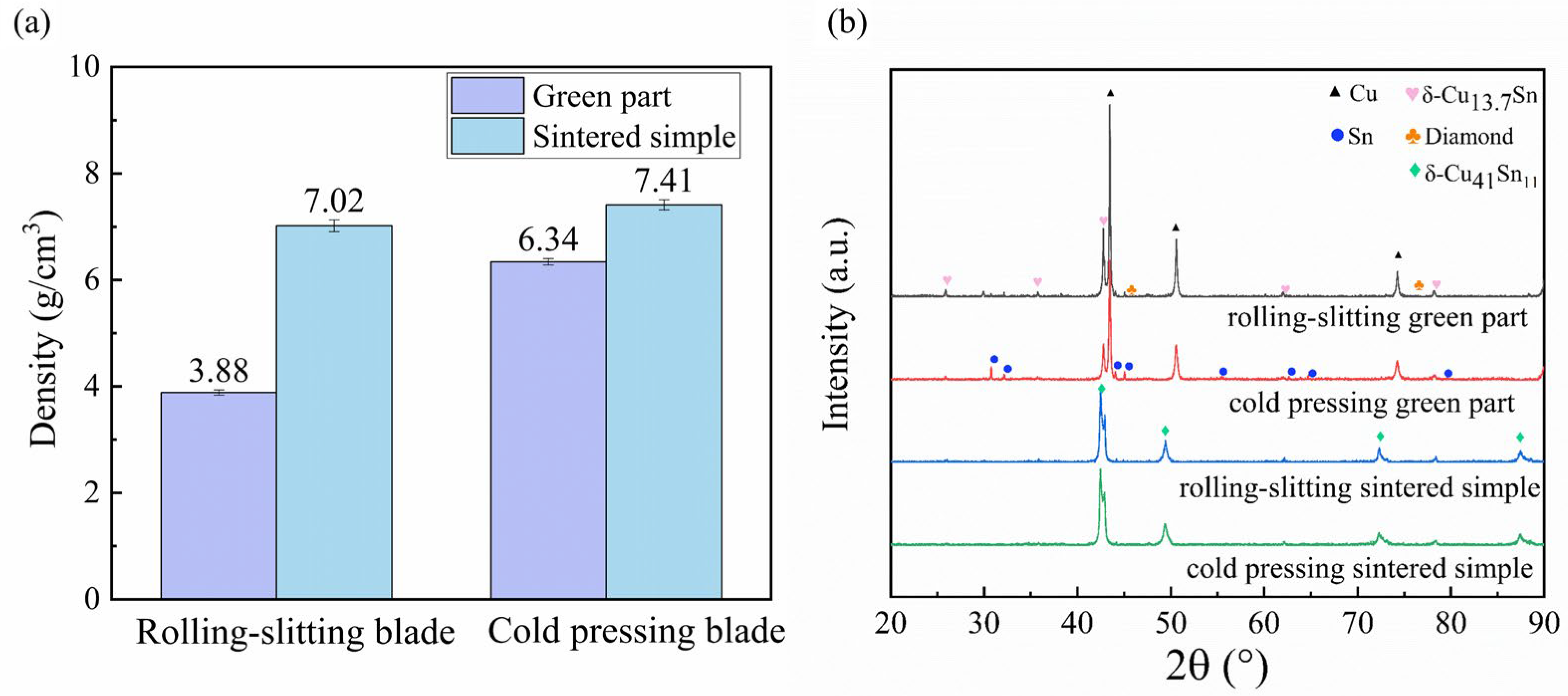
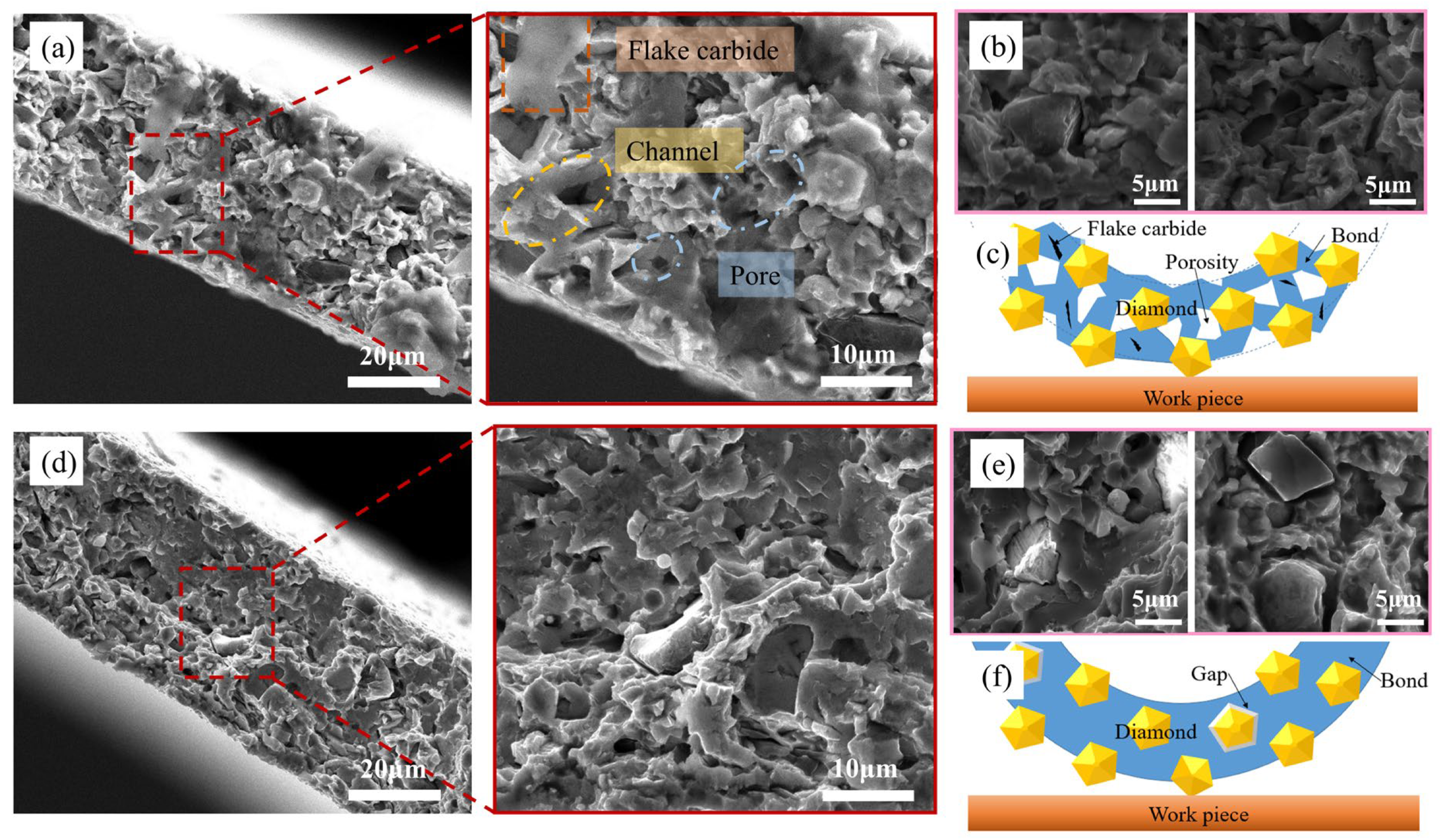
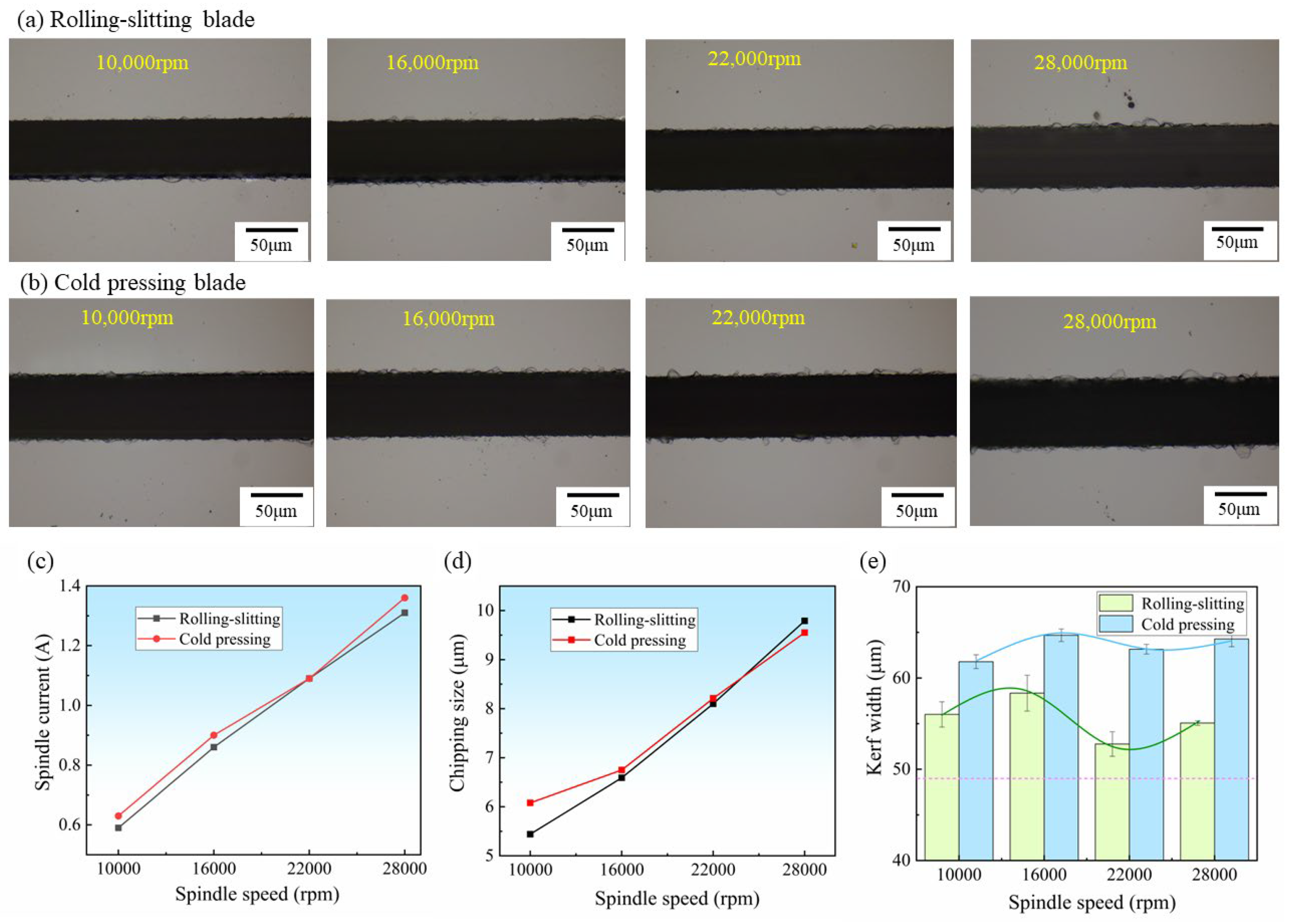
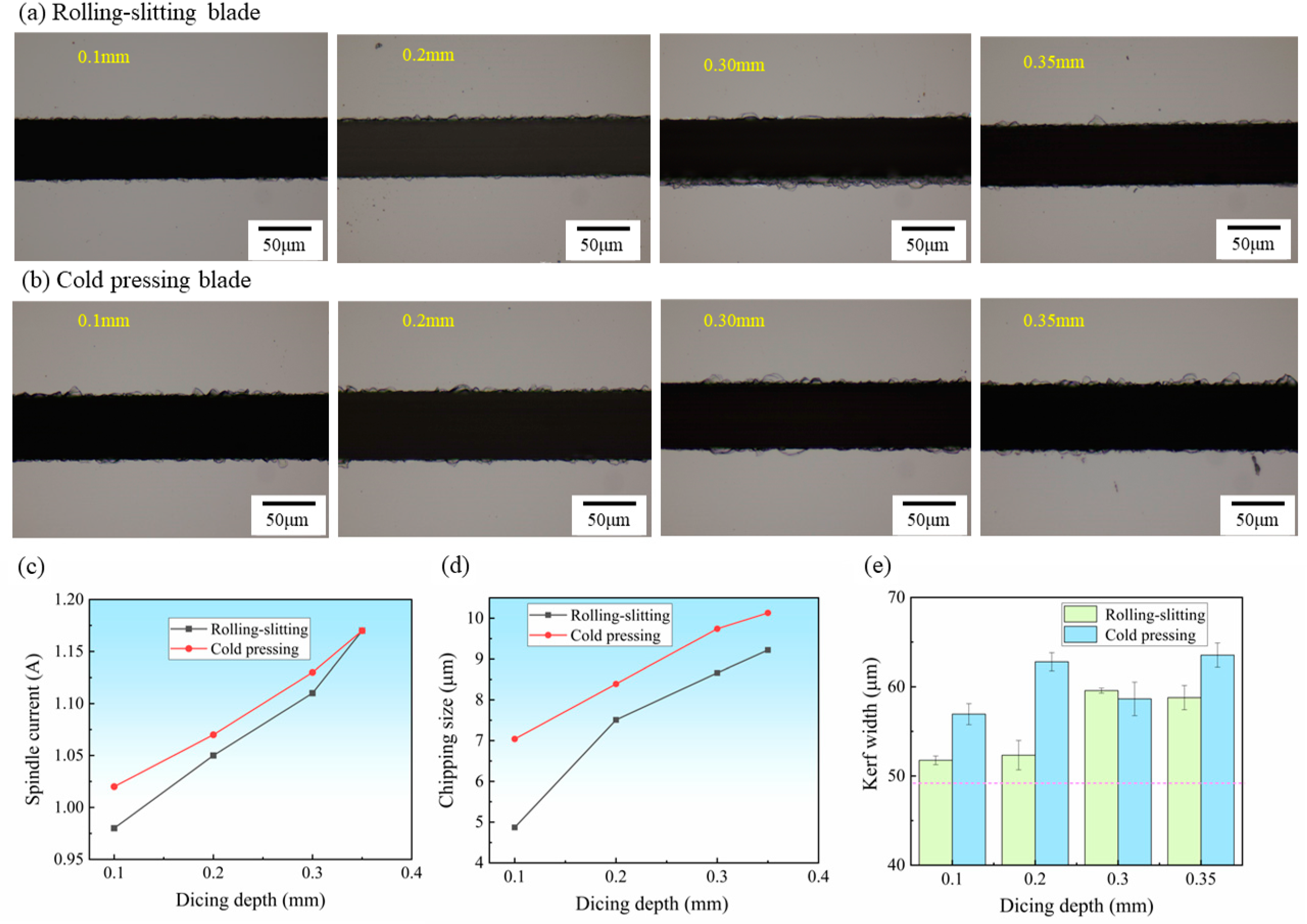
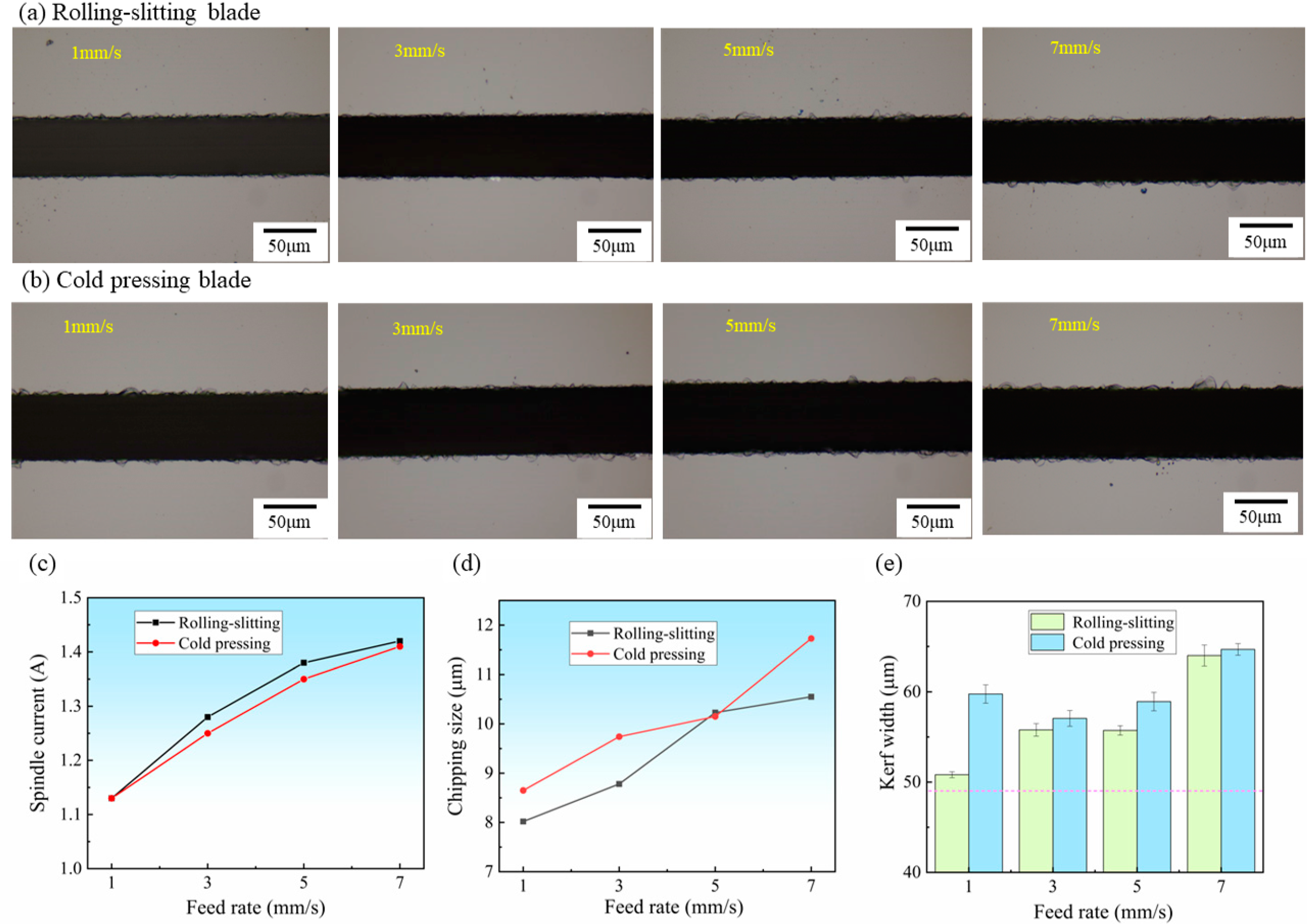
| Ingredient | Cu | Sn | CuSn10 | Fe | Diamond |
|---|---|---|---|---|---|
| Particle size (μm) | 8 | 15 | 10 | 10 | 8–12 |
| Percent wt.% | 65 | 15 | 15 | 2 | 3 |
| Apparatus | Automatic Dicing Saw | DISCO-DAD-3350 |
| Diamond blade | Size | 52 × 0.048 × 40 |
| Single silicon carbide | Type | 4H-SiC-350 µm |
| Dicing direction | ||
| Dicing parameters | Spindle speed | 10,000, 16,000, 22,000, 28,000 rpm |
| feed rate | 1, 3, 5, 7 mm/s | |
| Dicing depth | 0.1, 0.2, 0.3, 0.35 mm |
Publisher’s Note: MDPI stays neutral with regard to jurisdictional claims in published maps and institutional affiliations. |
© 2022 by the authors. Licensee MDPI, Basel, Switzerland. This article is an open access article distributed under the terms and conditions of the Creative Commons Attribution (CC BY) license (https://creativecommons.org/licenses/by/4.0/).
Share and Cite
Feng, Y.; Li, K.; Dou, Z.; Zhang, Z.; Guo, B. High-Speed Dicing of SiC Wafers with 0.048 mm Diamond Blades via Rolling-Slitting. Materials 2022, 15, 8083. https://doi.org/10.3390/ma15228083
Feng Y, Li K, Dou Z, Zhang Z, Guo B. High-Speed Dicing of SiC Wafers with 0.048 mm Diamond Blades via Rolling-Slitting. Materials. 2022; 15(22):8083. https://doi.org/10.3390/ma15228083
Chicago/Turabian StyleFeng, Yuanru, Kenan Li, Zhen Dou, Zhengwen Zhang, and Bing Guo. 2022. "High-Speed Dicing of SiC Wafers with 0.048 mm Diamond Blades via Rolling-Slitting" Materials 15, no. 22: 8083. https://doi.org/10.3390/ma15228083
APA StyleFeng, Y., Li, K., Dou, Z., Zhang, Z., & Guo, B. (2022). High-Speed Dicing of SiC Wafers with 0.048 mm Diamond Blades via Rolling-Slitting. Materials, 15(22), 8083. https://doi.org/10.3390/ma15228083






